Abstract
Climate control in a pixel non-uniformity metro system includes regulating the air, humidity, and temperature quality within metro trains and stations to ensure passenger comfort and safety. The climate control system in a PNU metro system combines intelligent algorithms, energy-efficient practices, and advanced technologies to make a healthy and comfortable environment for passengers while reducing energy consumption. The proposed an automated climate control using an improved salp swarm algorithm with an optimal ensemble learning technique examines the underlying factors, including indoor air temperature, wind direction, indoor air relative humidity, light sensor 1 (wavelength), return air relative humidity, supply air temperature, wind speed, supply air relative humidity, airflow rate, and return air temperature. Moreover, this new proposed technique applies ISSA to elect an optimal set of features. Then, the climate control process takes place using an ensemble learning approach comprising long short-term memory, gated recurrent unit, and recurrent neural network. Lastly, the Harris hawks optimization algorithm can be employed to adjust the hyperparameters related to the ensemble learning models. The extensive results demonstrated the supremacy of the proposed algorithms over other approaches to the climate control process on PNU metro systems.
1. Introduction
Railway systems have an extensive historical backbone of every society and exhibit significant attention to their environmental emission and fuel usage [1]. Nevertheless, railway facilities can be functioned by alternating current (AC) electricity, which does not contribute to a higher emission rate at the end users globally. Thus, it is the most supportable transport available option. Still, the electrical energy could be more precise; it comes out of the grid [2]. Therefore, when it is clean at the end destination, it is not at the source, and it does harm the surroundings. The world’s electricity is mainly produced from carbon-based sources. Thus, the railway sectors will face similar prospects of considering alternate energy sources than electricity [3]. Although more concentrated research has been in mobility and renewable energy, their applications in railway transportation are still being considered. The huge models and developments of the metro transmission system have recently become dedicated to optimizing energy consumption in the essential field.
The pixel non-uniformity (PNU) metro system is mentioned as the subway or metro transportation network operated by PNU inside its surrounding regions or campus [4]. The metro system is designed to offer proficient, supportable, and suitable transportation opportunities for faculty, staff, students, and visitors. It provides a dependable mode of transportation, mitigating traffic congestion and reducing reliance on private vehicles in the campus regions. PNU’s metro system contains a network of elevated or underground train lines that connect the different crucial locations within the surroundings [5]. The metro system comprises multiple stations around the campus and close-by zones. These stations help as access facilities for passengers to dismount or board the trains. Stations are designed with technological infrastructures, including platform facilities, automated fare collection systems, ticketing counters, and amenities like restrooms and seating areas [6]. The PNU metro system emphasizes maintainability in its execution. This comprises the application of waste management systems, climate control measures, and energy-proficient technologies [7].
The metro system may incorporate renewable energy sources, like solar power for train propulsion, reduction of its carbon footprint, and station operations [8]. Climate control in PNU’s metro system is an essential feature of ensuring pleasant and affluent environments for travelers, with the optimization of energy consumption [9]. The metro system utilizes different strategies and technologies for regulating the humidity, air quality, and temperature inside the trains and stations. Proficient climate control systems can improve travelers’ comprehensive experiences while reducing energy waste [10]. By applying efficient climate control, PNU’s metro system struggles to offer travelers a suitable and pleasant traveling experience while reducing environmental effects and energy consumption [11]. Continuously maintaining and monitoring adaptable energy-proficient technologies is essential inside the metro systems.
This study presents automated climate control using an improved salp swarm algorithm with an optimal ensemble learning (ACC-ISSAOEL) technique for PNU metro systems. Primarily, the ACC-ISSAOEL technique applies ISSA to elect an optimal set of features. Then, the climate control process takes place using an ensemble learning approach comprising long short-term memory (LSTM), a gated recurrent unit (GRU), and a recurrent neural network (RNN). Lastly, the Harris hawks optimization (HHO) algorithm can adjust the hyperparameters based on the ensemble learning algorithms. The simulation value analysis of the ACC-ISSAOEL technique is tested on a climate control dataset.
The main contribution of this paper:
- To develop automatic climate control for PNU metro systems utilizing an upgraded salp swarm algorithm with an optimal ensemble learning (ACC-ISSAOEL) method.
- The ACC-ISSAOEL technique that is being demonstrated examines the underlying variables that include the following: supply air temperature, return air temperature, supply air temperature, wind speed, supply air relative humidity, airflow rate, and indoor air temperature.
- Additionally, the ACC-ISSAOEL approach uses ISSA to choose the best possible combination of characteristics.
- Using an ensemble learning approach, the temperature control process uses LSTM, a GRU, and an RNN. Finally, the ensemble learning model hyperparameters can be modified using the Harris hawks optimization (HHO) algorithm.
- The climate control dataset was used to test the simulation analysis of the ACC-ISSAOEL method. The comprehensive results showed that the ACC-ISSAOEL algorithms were superior to other methods for controlling the climate on PNU metro systems.
The remainder of this paper is organized as follows: Section 2 explores the literature review, which has covered the issues of existing works, while Section 3 discusses the recommended technique for identified problems. Section 4 then engages the proposed system performance in a discussion, and Section 5 concludes the final outcomes of the recommended model.
2. Literature Review
In [12], a new human-centric automatic climate control technique was developed, which uses microclimate devices integrated into a heat pump or electric HVAC system. This method offers extra merits like improved customization, energy saving, and less time. Nova et al. [13] proposed a new climate control technique for an adaptable facade utilizing an automatic control system. This work aims to analyze the energy proficiency of a novel facade control technique. In an analytical investigation, Autodesk Green Building and Autodesk Insight studio were employed to the determination of the unidentified properties of climate adaptive facade structures, peak loads on the ventilation and air conditioning system, and consumption of energy for building as well as the proficiency to infiltration air, shading the designs, etc.
Chen and You [14] suggest an innovation for controlling the greenhouse indoor climate automatically by using the data-driven robust model predictive control (DDRMPC) system. The system integrates a dynamic control system of greenhouse humidity, CO2 concentration level, and temperature with a DDR optimization technique that precisely and severely captures uncertainty in forecasting weather errors. An affine disturbance feedback strategy is used to acquire manageable estimations of optimum control for achieving the optimization difficulties in DDRMPC. Peng et al. [15] aimed to examine the process of creating HVAC methods that automatically respond to local occupant temperature priorities. An online-based learning control policy with its design was proposed to make occupant-centric in-door temperature surroundings. The NN model and its relevant hyperparameters are intended to frame temperature priorities by the time-reliant setpoints learned from the dynamic contexts. To determine the set points for HVAC techniques utilized by a set of particular rules.
Argo et al. [16] proposed a technique for microclimatic management in pilot-scale indoor aeroponics models. From this aim, three fuzzy logic controllers were applied and estimated to preserve parameters in plant chambers, such as relative humidity, temperature, and light intensity at desirable setpoints managed by an embedded system control model employed by the software BASCOM-AVR (Version 2.0.8.5). Smarra et al. [17] established a new concept for predicting the control based on historically creating the information leverage of machine learning (ML) designs, namely random forests and regression trees. The data-driven model predictive control (DPC) was applied to three distinguishable instance research to demonstrate its robustness, scalability, and performance. In the primary case studies, the consideration of a standard MPC controller utilizing bilinear building models afterward applies DPC to simulate an information set that derives a controller based only on the information and from the bilinear model.
Vatanparvar and Faruque [18] suggested a self-propelled climate control technology: awareness of the battery performance and behavior while maintaining the traveler’s thermal support. In the technology, cabin temperature and the battery parameters are evaluated, and models and the HVAC application are adjusted and optimized concerning HVAC power desires and the electric motor. During the cabin, temperatures are preserved by the prediction and optimization of the technique states in the future, which can reduce battery stress. Hodás and Pultznerová [19] demonstrated a great deal of railway tracks model illustrate the significance of the process of the non-transportation load under the negative temperature with several variants of climate that monitor the changeover of zero isotherms by way of the layers of railway subgrade. When the subgrade layer of the railway developments is created with higher durability and quality during long-time operation, the axis of the railway lines will maintain its geometrical spatial location.
The research by Saleh et al. [20] on design and control strategies to reduce energy use recommends a cleaner energy source for power. The objective of this article is the automated people mover (PNU-APM) at Princess Nourah Bint Abdulrahman University. Two application areas for using this technology have been investigated. First, a p-V solar energy alternative might be applied, as the metro system is currently entirely powered by electricity. Second, possibilities for a metro operation’s design and management are discussed and examined, including the usage of solar power. The HVAC load, the biggest energy consumer, has been reduced in several ways. According to the findings, energy consumption can be significantly decreased by adopting p-v solar sources and implementing some suggested control methods. Some of the drawbacks of solar energy are also discussed.
Cheng et al. [21] proposed “Artificial Intelligence (AI)-Assisted Control of Heating, Ventilation, and Air Conditioning (HVAC)”. Only 3 of the 18 AI-based solutions developed for HVAC management over the last two decades have received considerable traction: weather forecasting, optimization, and predictive controls. According to the data, HVAC systems employing AI consume less energy than those maintained using standard energy management system (EMS) methodologies. This disparity stems from the limitations of present sensors, which need to be revised to match the expectations of AI-enhanced capability. Errors in modern sensors are often fewer than 5%.
Kwon et al. [22] created a reinforcement learning-driven energy management agent capable of effectively managing acceptable dust concentrations at the station through the device-coordinated operation. Their strategy entailed developing a predictive model to measure the station’s permissible dust content. This was accomplished by creating a transfer function with an ANN taught through supervised learning. The Markov decision-making process was used to frame the optimization problem. The Deep Q-Network (DQN) approach was used with the ANN to augment the predictive model. This combination aided in determining the best course of action for operating the blowers and air conditioners based on the current conditions. A comparison of the proposed strategy with the standard approach found that the former performed better, particularly in reducing acceptable dust levels.
Norouzi et al. [23] attempt to build a model for predicting indoor temperatures while also analyzing the viability of data-driven techniques. The performance of these algorithms is evaluated and compared. Essential model parameters are organized before picking the best architecture. Predictive models for interior temperatures are developed using real-world data. The results demonstrate the superior prediction skills of all tested models. Notably, the deep neural network model described in this study has the best level of accuracy with an average RMSE of 0.16 °C, indicating the most promising potential for constructing a digital twin.
Taheri et al. [24] proposed the combination of composite nano-lubricants and optimization through fuzzy modeling to improve the efficiency of vehicle air conditioning systems. The growing demand for energy-efficient automobiles and the significant fuel consumption associated with present mobile enclosure HVAC systems has spurred a growing interest in re-evaluating traditional methodologies. This impetus highlights the increased investigation and scrutiny of HVAC system components, control approaches, and overall design, all to improve operational efficiency.
Huang et al. [25] proposed the multistage constant-compressor speed (MCCS) system, a novel control strategy for air conditioning systems based on genetic algorithm optimization. This approach used cabin temperature and compressor speed as input and output factors. The suggested MCCS system was compared to traditional on/off controllers and the engineering-applied (EA) air conditioning control approach. The results showed that the MCCS controller beat previous controllers regarding energy conservation and overall performance. This demonstrates its potential as a good alternative for air conditioning systems in electric vehicles, contributing to improved efficiency and functionality.
Ahmed et al. [26] demonstrated a unique thermoelectric cooling system installed on the roof of a car. They created an abstract, time-varying thermal model and ran an analysis on it. The results showed that when operating at 1000 watts of input power, the thermoelectric cooling system significantly reduced cabin temperature, keeping it at around 26 degrees Celsius. This feat outperformed the traditional system’s performance. Despite having a lower coefficient of performance (COP), the proposed system remains competitive due to its beneficial features, such as lower annual expenditures than the conventional configuration.
Research Gap
- While AI techniques have been increasingly applied to metro climate control systems, there appears to be a gap in the literature regarding the use of optimal ensemble learning methods specifically for this purpose. Most existing research focuses on single AI algorithms, and there is a need to investigate the potential benefits of ensemble techniques in improving the accuracy, resilience, and flexibility of automated climate management systems within metro systems.
- Many AI-based metro climate management systems rely on historical data and predetermined rules, which may not fully leverage the dynamic nature of metro surroundings. There is a research gap in successfully integrating optimal ensemble learning with real-time data streams from various sensors inside the metro system to enable proactive and responsive temperature control modifications.
- Each metro system has distinct structural and operational characteristics influencing temperature control requirements. Existing research frequently needs a thorough examination of how optimal ensemble learning might be adapted to meet these various designs, such as underground and above-ground metro lines, different passenger capacities, and station layouts.
3. Materials and Methods
This study developed a new ACC-ISSAOEL method for automatic climate control on PNU metro systems. The presented ACC-ISSAOEL technique examines the underlying factors such as return air temperature, indoor air temperature, return air relative humidity, indoor air relative humidity, supply air temperature, supply air relative humidity, wind speed, wind direction, light sensor 1 (Wavelength), and airflow rate. In addition, the ACC-ISSAOEL technique follows three significant processes such as ISSA-based feature selection, ensemble learning-based classification, and HHO-based hyperparameter tuning. Figure 1 shows the working process of the ACC-ISSAOEL method.
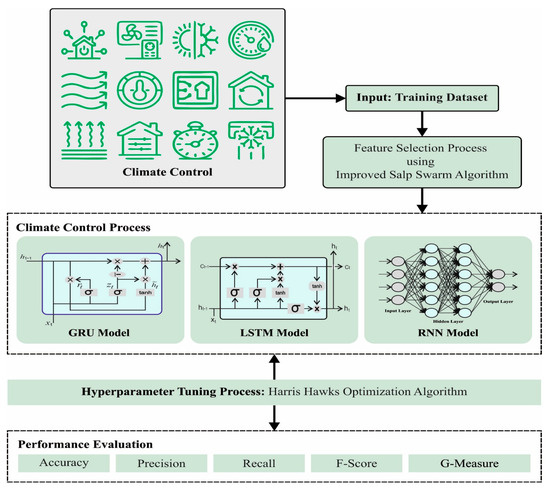
Figure 1.
Working process of ACC-ISSAOEL method.
3.1. ISSA-Based Feature Selection
This work uses the ISSA to elect an optimal set of features. The evolutionary computing method is nature-inspired and has heuristic manners of searching for an optimum method to fulfill the goals [27]. Due to the searching potential and heuristic nature, this method is considered to be more optimistic. Instead of using fixed threshold values for targeted data filtration, this method employs a fitness function to examine and traverse the whole feature spectrum inside the input dataset. It employs many iterations, considering various feature combinations across the input feature space. Thus, it is considered an optimum solution over other manual FS techniques. For instance, sea species for food and nearly have similar search conditions. Figure 2 depicts the flowchart of SSA.
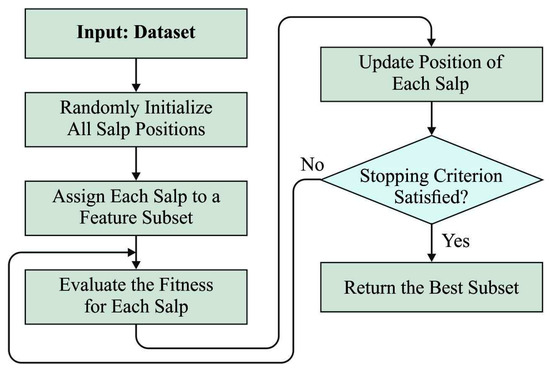
Figure 2.
Flowchart of SSA.
Similarly, the salp has a chain-like structure and is a marine organism with a morphology similar to jellyfish. It maintains and pushes itself through the use of a feeding filter. While searching for food, the leader salps lead the chain and search for the optimum position to search for food. When the optimum position is found, the entire salp chain is updated afterward, updating the leader position. This work provides a search space where the initial weight is provided to the salp population.
The importance constantly remains updated via upper and lower boundaries concerning the better location found by individual salps. This technique exploits an ensemble classifier while evaluating the fitness of all the iterations. It considers the maximization of accuracy and the reduction of features with the set of features selected. The main stages of the ISSA-FS technique are previously mentioned that have six steps; the random value initialized the salp location, and it can be mathematically expressed as follows:
where , represents the leader location of the salp chain, utilized inertia parameter, that has [0, 1] interval of value, represents the location of the food source. denotes the random value in the interval of zero and one. It balances the followers’ position, which was updated by the following expression:
where denotes the location of follower positions of the salp chain; indicates the dimension of feature space. But the ISSA utilized an updated FF based on the ensemble classifier for updating the salp position and selecting the accurately categorized subset of features. The FF can be evaluated by the following expression:
The constants and are in charge of determining fitness. The classifier’s error rate, E(C), is represented by the feature subset |F| of the total features, |T|. Based on the fitness value, FS can be controlled by a single dimension vector in the [0, 1] range. Binary values within this range display 1 for FS and 0 for not FS. It is eliminated using a feature subset from the salp population.
3.2. Ensemble Learning-Based Climate Control
For climate control process, the proposed model performs ensemble learning process comprising three DL models, namely RNN, LSTM, and GRU [28].
3.2.1. RNN Model
RNN has the potential to deal with the sequence with temporal relationship, and it is extensively used in resolving time-varying problems, particularly natural language processing. Unlike typical NN with no connection within the hidden layer (HL), RNN can connect HLs with the prior one. Thus, an RNN possesses a deep structure, and the HL counts are equivalent to the length of the input series.
Here, RNN is trained and established as a sub-model for ensemble prediction. It is essential to keep the diversity of sub-models to exploit ensemble technology. To overcome these challenges, various techniques are considered and discussed as follows:
Consequently, two recurrent structures are used to build a sub-model of RNN, such as LSTM and GRU.
3.2.2. LSTM Model
The simple RNN has several connections between existing and prior HLs. Therefore, training a network becomes challenging, but the gradient disappearing problem will rise. LSTM was introduced in 1997 and enhanced during the tremendous growth of the DL technique to resolve these problems. It is a basic unit for the RNN layers capable of remembering short-term memory that lasts longer. The memory cell, input, forget, and output gates are the four major parts of the LSTM block.
The figure shows that two parallel lines work together to handle the HL data and memory, which is the main difference from the simple RNN. HL line h calculates its resultant value dependent upon input and prior hidden data, and the calculation outcome is transmitted to the memory line and the next layer. The memory line receives these outcomes and forgets the redundant ones, which produces an output to affect the HL line. The realization of the abovementioned function was evident by this controllable gate with different equations and architectures:
Input gate. This gate receives data from the existing input and the prior HL, and it can be computed as follows:
In Equation (5), refers to the output of the input gate; denotes the bias of the input gate; and show the existing input and prior HL output, correspondingly; and denotes the weight for the
and inputs, correspondingly; indicates the activation function as follows:
In Equation (6), indicates an independent parameter of activation function.
Furthermore, the input gate can obtain a temporary memory:
In Equation (7), , and indicate weighted for , weighted for , and biased for , correspondingly.
Forget gate. The computation equation of the output gate is similar to the input gate with dissimilar weights and bias :
Memory cell. The existing memory was evaluated by the following expression:
In Equation (9), denotes the prior output of memory cells.
Output gate. Its outcome is defined by the existing input, the present memory, and prior HL output. The computation equation was represented using the following expression:
where and denote the output of output gate and the existing HL, correspondingly; , and show the weight for and and bias for , correspondingly.
3.2.3. GRU Model
GRU is a newly developed RNN architecture, the simplest form of LSTM. There exist two main changes in GRU. Firstly, forget and input gates of LSTM are combined, which produces a sole update gate. Next, the 2 lines in LSTM, viz., HL and the memory, are combined. The following equation was considered for the calculation in GRU:
where indicates the concluding output of the GRU block. and denote the existing input and prior outcome of GRU, correspondingly, , and show the weight in GRU; , and are biased, and and represents the output during the intermediate procedure.
3.3. HHO-Based Parameter Tuning
The HHO algorithm is used to adjust the hyperparameter values of the ensemble models. HHO is a meta-heuristic optimizer algorithm utilized for the DenseHHO architecture [29,30], and was stimulated by the hunting behaviors of HHs. The HHO technique can resolve the problems of different optimization techniques, namely parameter optimization, function optimization, and feature selection for ML algorithms [31,32,33,34]. The subsequent steps need to be taken to implement the algorithm. Consequently, the elite hawk takes the lead in the search technique, which represents the best solution [35,36,37]. They stimulate the behaviors of the better hawks in the population to maintain their location. Thus, the algorithm could converge toward a potential solution using the exploitation process. Three types of hunting behaviors are observed in HHs:
- Exploitation: HHs attempt to enhance the solution given by the individual.
- Exploration: HHs randomly fly to determine new areas where they can search.
- Intensification: HHs coordinate their efforts to find their prey.
The HHO [38,39] will be used to enhance the network hyperparameter after initializing the pre-trained module. The HHO exploits the following hunting behaviors to search for an optimum solution:
where indicates the random integer within (), and are two random selection hawks, and shows the existing iteration. The HHs guide the optimization technique by updating the position according to the other hawks:
The fitness choice is a major aspect of the HHO algorithm. An encoding outcome was applied for evaluating the better candidate performance. The accuracy value is the most important condition applied to design a FF.
where and represent the true and the false positive values.
4. Results
The climate control results of the ACC-ISSAOEL method are tested utilizing the dataset comprising 7500 instances with three classes as shown in Table 1.

Table 1.
Details of database.
The dataset comprises several features such as indoor air temperature, airflow rate, supply air temperature, return air temperature, indoor air relative humidity, wind direction, return air relative humidity, wind speed, light sensor 1 (wavelength), supply air relative humidity, class ranges (Level1/Level2/Level3).
The confusion matrices of the ACC-ISSAOEL method under the climate control process are depicted in Figure 3. The outcomes identified that the ACC-ISSAOEL method detects three types of class levels efficiently.
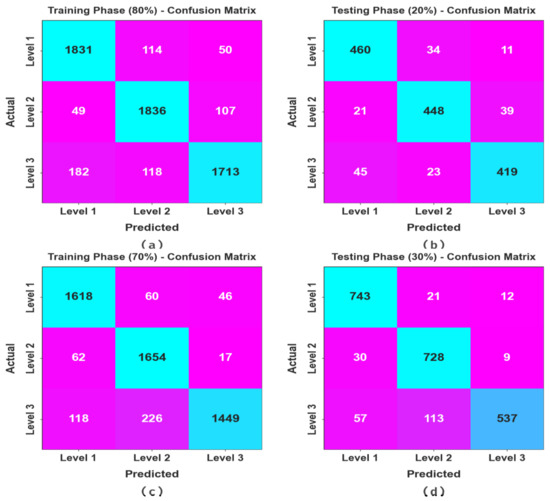
Figure 3.
Confusion matrices of (a,b) 80:20 of TR set/TS set and (c,d) 70:30 of TR set/TS set.
4.1. The Advantages of Methodology
The ACC-ISSAOEL technology enhances climate control by automatically regulating real-time temperature, ventilation, and lighting. This improves energy efficiency, lowering PNU metro system energy consumption and expenditures.
By utilizing AI and the upgraded salp swarm algorithm, the system is able to make precise predictions and adjustments to the temperature control settings. This avoids wasting energy and leads to significant cost savings over time.
The ACC-ISSAOEL technique’s AI models can anticipate changes in weather patterns and passenger loads, allowing for proactive adjustments to temperature control settings. This predictive capability reduces unexpected changes and interruptions in the surroundings of metro cars.
Implementing the ACC-ISSAOEL technology demonstrates the PNU metro system’s dedication to embracing cutting-edge technologies. This innovation increases operational efficiency and the metro system’s general reputation and attractiveness.
4.2. Limitations of the Proposed Work
Because the proposed technique (ACC-ISSAOEL) is customized especially to the PNU metro system, it may need to be more generalizable to other metro systems or contexts. The technique’s effectiveness may not be directly transferable to other transportation systems with different infrastructures, passenger density, and climatic variables.
The technique could presume homogeneity regarding passenger preferences, comfort levels, and usage patterns. In practice, passengers’ temperature and comfort preferences may vary considerably, making it challenging to discover a single ideal control technique that satisfies all passengers.
The performance of the improved salp swarm algorithm (ISSAOEL) may be sensitive to hyperparameter selection, and fine-tuning these parameters may be a time-consuming and domain-specific procedure.
The metro system’s infrastructure, technology, and passenger behavior may change. With regular updates and maintenance, which might be resource-intensive, the proposed technique may be able to respond to these changes.
There may be a need for more extensive validation and testing in real-world circumstances in the article. The actual benefits and limits of the suggested technique may only be correctly recognized if comprehensive testing and validation on a varied range of settings and scenarios are performed.
4.3. Performance Metrics
A model’s performance can be described using evaluation measures. Evaluation measures are essential because they help distinguish between the outcomes of different learning models. The performance measures used to evaluate the effectiveness of the suggested models are listed in Table 2. These metrics include execution time, precision, sensitivity, F-score, accuracy, and RMSE (root mean square error).

Table 2.
Performance metrics that are used to assess how well suggested models perform.
4.4. Statistical Analysis
The influence of the AI-based automated climate control system on energy consumption in the PNU metro system was evaluated using a z-test. The null hypothesis (H0) states that the mean energy consumption before and after the implementation of the AI-based system does not differ significantly. The alternative hypothesis (Ha) posits that after the installation of the AI-based system, average energy consumption is significantly reduced. Alternative hypothesis H1: performance is significantly different. The test was carried out for all samples. The result: Since F_cal = 51.562 > F_tab(0.06)(27.144) = 1.572. Therefore, H0 is rejected and H1 is accepted.
In Table 3 and Figure 4, the climate control outcome of the ACC-ISSAOEL system under 80:20 of the TR set/TS set is shown. The simulation outcome depicts that the ACC-ISSAOEL algorithm detects three levels proficiently. On 80% of the TR set, the ACC-ISSAOEL method gains average , , , , and of 93.11%, 89.73%, 89.68%, 89.65%, and 89.68% respectively. At the same time, on 20% of the TS set, the ACC-ISSAOEL technique gains average , , , , and of 92.31%, 88.50%, 88.44%, 88.45%, and 88.46%, respectively.

Table 3.
Climate control outcome of ACC-ISSAOEL method on 80:20 of TR set/TS set.
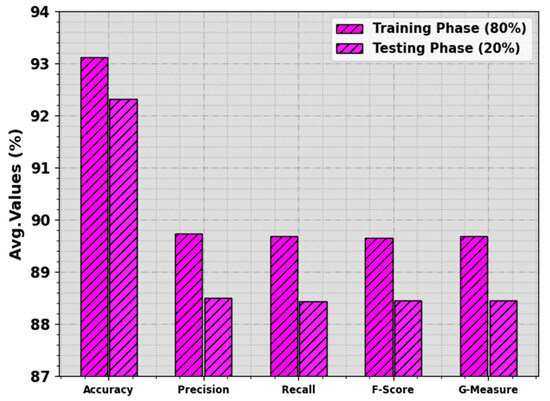
Figure 4.
Average outcome of ACC-ISSAOEL algorithm on 80:20 of TR set/TS set.
Figure 5 shows the training accuracy and of the ACC-ISSAOEL technique on 80:20 of TR set/TS set. is computed by evaluating the ACC-ISSAOEL method on TR dataset, whereas is determined by the evaluation of the performance on a separate testing dataset. The results exhibit that and increase with an upsurge in epochs. Consequently, the performance of the ACC-ISSAOEL technique gets improved on the TR and TS dataset with a rise in the number of epochs.
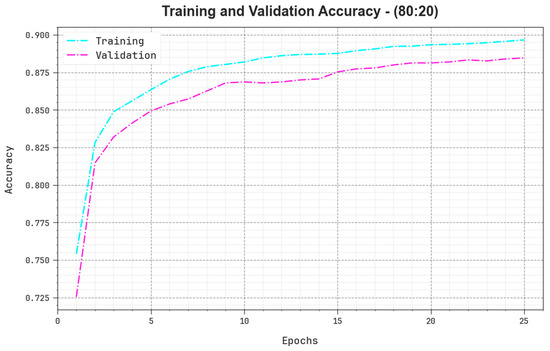
Figure 5.
outcome of ACC-ISSAOEL method on 80:20 of TR set/TS set.
In Figure 6, the and results of the ACC-ISSAOEL method on 80:20 of the TR set/TS set are shown. defines the error among the predictive performance and original values on the TR data. represents the measure of the performance of the ACC-ISSAOEL technique on individual validation data. The outcomes indicate that and tend to reduce with rising epochs. They depict the enhanced performance of the ACC-ISSAOEL method and its capability to generate accurate classification. The reduced value of and demonstrates the enhanced performance of the ACC-ISSAOEL method on capturing patterns and relationships.
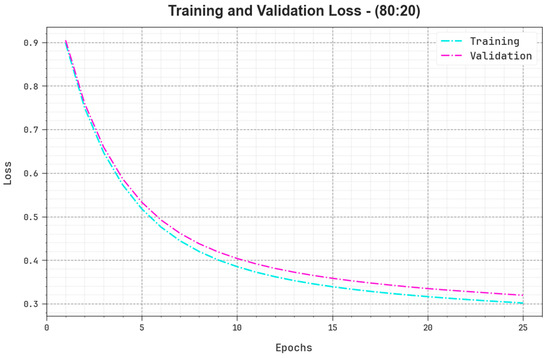
Figure 6.
Loss outcome of ACC-ISSAOEL approach on 80:20 of TR set/TS set.
In Table 4 and Figure 7, the climate control outcomes of the ACC-ISSAOEL method under 70:30 of the TR set/TS set. The simulation value demonstrated that the ACC-ISSAOEL algorithm detects three levels proficiently. On 70% of the TR set, the ACC-ISSAOEL technique gains average , , , , and of 93.28%, 90.36%, 90.04%, 89.88%, and 90.04%, respectively. At the same time, on 30% of the TS set, the ACC-ISSAOEL technique gains average , , , , and of 92.83%, 90.07%, 88.87%, 88.94%, and 89.20%, respectively.

Table 4.
Climate control outcome of ACC-ISSAOEL method on 70:30 of TR set/TS set.
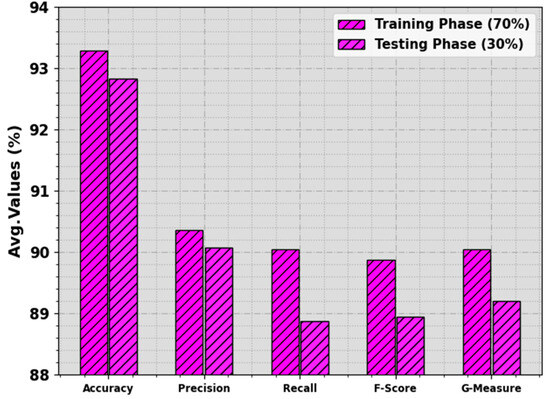
Figure 7.
Average outcome of ACC-ISSAOEL algorithm on 70:30 of TR set/TS set.
In Figure 8 shows the training accuracy , and of the ACC-ISSAOEL technique on 70:30 of the TR set/TS set. is computed by evaluating the evaluation of the ACC-ISSAOEL technique on the TR dataset whereas is determined by the performance on a separate testing dataset. The outcomes exhibit that and increase with an upsurge in epochs. Thus, the performance of the ACC-ISSAOEL method gets improved on the TR and TS dataset with a rise in the number of epochs.
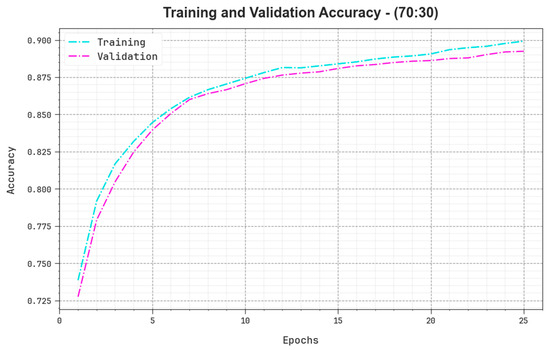
Figure 8.
outcome of ACC-ISSAOEL method on 70:30 of TR set/TS set.
In Figure 9, the and results of the ACC-ISSAOEL technique on 70:30 of the TR set/TS set are shown. defines the error among the predictive performance and original values on the TR data. represents the measure of the performance of the ACC-ISSAOEL technique on individual validation data. The results indicate that and tend to decrease with rising epochs. It describes the improved performance of the ACC-ISSAOEL technique and its capability to generate accurate classification. The reduced value of and demonstrates the enhanced performance of the ACC-ISSAOEL technique in capturing patterns and relationships.

Figure 9.
Loss outcome of ACC-ISSAOEL approach on 70:30 of TR set/TS set.
Finally, Table 5 and Figure 10 compare the climate control results of the ACC-ISSAOEL with current techniques. The results highlight that the DT, NB, and AE techniques show the least performance, and the RF, ELM, and DBN methods obtained slightly improved performance. Next, the ACC-ISSAOEL technique resulted in superior performance, with maximum of 93.28%, of 90.36%, of 90.04%, and of 89.88%. Thus, the ACC-ISSAOEL technique can be used for effective climate control in PNU metro systems.

Table 5.
Comparative outcome of the ACC-ISSAOEL method with other techniques.
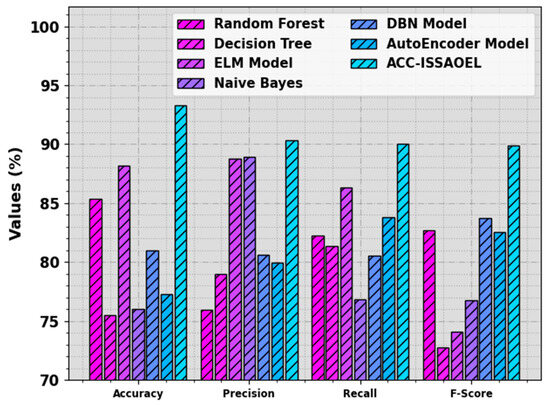
Figure 10.
Comparative outcome of the ACC-ISSAOEL method with other techniques.
5. Conclusions
In conclusion, the modeling of an artificial intelligence-based PNU metro system represents a significant step forward in the field of urban transportation. This novel strategy offers increased efficiency, better resource use, and a better passenger experience by leveraging the power of AI. The combination of AI-driven predictive analytics, automation, and adaptive control mechanisms has the potential to transform urban mobility. However, successful deployment depends on overcoming technical obstacles, guaranteeing robust cybersecurity, and gaining public support. This study presents an automated climate control using an improved salp swarm algorithm with an optimal ensemble learning (ACC-ISSAOEL) technique for PNU metro systems. The proposed ACC-ISSAOEL technique examines the underlying factors, including indoor air temperature, wind direction, indoor air relative humidity, light sensor 1 (wavelength), return air relative humidity, supply air temperature, wind speed, supply air relative humidity, airflow rate, and return air temperature. Moreover, the ACC-ISSAOEL technique applies ISSA to elect an optimal set of features. Then, the climate control process takes place using an ensemble learning approach comprising LSTM, GRU, and RNN. Lastly, the Harris hawks optimization (HHO) algorithm can be employed to adjust the hyperparameters related to the ensemble learning models. Climate control outcome of the ACC-ISSAOEL system under 80:20 of the TR set/TS set. On 80% of TR set, the ACC-ISSAOEL method gains average , , , , and of 93.11%, 89.73%, 89.68%, 89.65%, and 89.68%, respectively. In the future, the ACC-ISSAOEL algorithm will be tested on largescale real-time datasets. The enhanced SSA and ensemble learning algorithm would need to be implemented into the software architecture of the temperature control system. Researchers may run extensive simulations using large-scale real-time datasets before deploying the system in the field. Simulations could fine-tune parameters, evaluate algorithm performance, and forecast algorithm behavior in diverse settings. The system’s performance would be regularly evaluated during the real-world testing phase. Energy efficiency, temperature stability, and user comfort levels will be considered.
Author Contributions
Conceptualization, S.J. and W.S.; methodology, S.J.; software, M.M.A.L.; validation, S.J., W.S. and H.M.A.; formal analysis, W.S.; investigation, S.J.; resources, W.S.; data curation, S.J.; writing—original draft, S.J.; writing—review and editing, W.S.; visualization, W.S.; supervision, S.J.; project administration, W.S.; funding acquisition, S.J. All authors have read and agreed to the published version of the manuscript.
Funding
The authors extend their appreciation to the Deputyship for Research & Innovation, Ministry of Education in Saudi Arabia for funding this research work through the project number RI-44-0219.
Institutional Review Board Statement
Not Applicable
Informed Consent Statement
Not Applicable
Data Availability Statement
Not applicable.
Conflicts of Interest
The authors declare no conflict of interest.
References
- Thaduri, A.; Galar, D.; Kumar, U. Space weather climate impacts on railway infrastructure. Int. J. Syst. Assur. Eng. Manag. 2020, 11, 267–281. [Google Scholar] [CrossRef]
- Nakashydze, L.; Hilorme, T.; Nakashydze, I. Substantiating the criteria of choosing project solutions for climate control systems based on renewable energy sources. East. Eur. J. Enterp. Technol. 2020, 3, 42–50. [Google Scholar] [CrossRef]
- Barauskas, R.; Kriščiūnas, A.; Čalnerytė, D.; Pilipavičius, P.; Fyleris, T.; Daniulaitis, V.; Mikalauskis, R. Approach of AI-Based Automatic Climate Control in White Button Mushroom Growing Hall. Agriculture 2022, 12, 1921. [Google Scholar]
- Liu, Y.; Pang, Z.; Karlsson, M.; Gong, S. Anomaly detection based on machine learning in IoT-based vertical plant wall for indoor climate control. Build. Environ. 2020, 183, 107212. [Google Scholar]
- Costantino, A.; Comba, L.; Sicardi, G.; Bariani, M.; Fabrizio, E. Energy performance and climate control in mechanically ventilated greenhouses: A dynamic modelling-based assessment and investigation. Appl. Energy 2021, 288, 116583. [Google Scholar]
- Kuijpers, W.J.; Antunes, D.J.; van Mourik, S.; van Henten, E.J.; van de Molengraft, M.J. Weather forecast error modelling and performance analysis of automatic greenhouse climate control. Biosyst. Eng. 2022, 214, 207–229. [Google Scholar]
- Masoudi, Y.; Natarajan, S. 1D Modeling of HVAC Unit Air Flow for Automatic Climate Control Simulations; No. 2021-01-0215; SAE Technical Paper; SAE International: Warrendale, PA, USA, 2021. [Google Scholar]
- Soussi, M.; Chaibi, M.T.; Buchholz, M.; Saghrouni, Z. Comprehensive review on climate control and cooling systems in greenhouses under hot and arid conditions. Agronomy 2022, 12, 626. [Google Scholar]
- Pumijumnong, N.; Songtrirat, P.; Buajan, S.; Preechamart, S.; Chareonwong, U.; Muangsong, C. Climate control of cambial dynamics and tree-ring width in two tropical pines in Thailand. Agric. For. Meteorol. 2021, 303, 108394. [Google Scholar]
- Aleshkin, N.A.; Aleshkin, A.P.; Petrushevskaya, A.A. The formation of control actions in the automatic climate control system in the production of electronics based on the inclusion of a fuzzy controller in the recurrence algorithm. J. Phys. Conf. Ser. 2020, 1515, 052033. [Google Scholar]
- Tiwari, A.; Varandani, V.; Mandali, S.; Arsenault, J. Design of a Human-Centric Auto-Climate Control System for Electric Vehicles. SAE Int. J. Adv. Curr. Pract. Mobil. 2022, 5, 748–761. [Google Scholar]
- Nemova, D.V.; Bochkarev, S.D.; Andreeva, D.S. Climate-Adaptive Facades with Automatic Control System. Stroit. Unikal’nyh Zdanij Sooruz. 2022, 2, 67–78. [Google Scholar]
- Chen, W.H.; You, F. Semiclosed greenhouse climate control under uncertainty via machine learning and data-driven robust model predictive control. IEEE Trans. Control Syst. Technol. 2021, 30, 1186–1197. [Google Scholar] [CrossRef]
- Peng, Y.; Nagy, Z.; Schlüter, A. Temperature-preference learning with neural networks for occupant-centric building indoor climate controls. Build. Environ. 2019, 154, 296–308. [Google Scholar] [CrossRef]
- Argo, B.D.; Hendrawan, Y.; Ubaidillah, U. A fuzzy micro-climate controller for small indoor aeroponics systems. TELKOMNIKA (Telecommun. Comput. Electron. Control) 2019, 17, 3019–3026. [Google Scholar] [CrossRef]
- Smarra, F.; Jain, A.; De Rubeis, T.; Ambrosini, D.; D’Innocenzo, A.; Mangharam, R. Data-driven model predictive control using random forests for building energy optimization and climate control. Appl. Energy 2018, 226, 1252–1272. [Google Scholar] [CrossRef]
- Vatanparvar, K.; Faruque, M.A.A. Design and analysis of battery-aware automotive climate control for electric vehicles. ACM Trans. Embed. Comput. Syst. 2018, 17, 1–22. [Google Scholar] [CrossRef]
- Hodás, S.; Pultznerová, A. Modelling of railway track temperature regime with real heat-technical values for different climatic characteristics. Civ. Environ. Eng. 2017, 13, 134–142. [Google Scholar] [CrossRef]
- Saleh, W.; Justin, S.; Alsawah, G.; Al Ghamdi, T.; Lashin, M.M. Control Strategies for Energy Efficiency at PNU’s Metro System. Energies 2021, 14, 6660. [Google Scholar] [CrossRef]
- Cheng, C.C.; Lee, D. Artificial intelligence-assisted heating ventilation and air conditioning control and the unmet demand for sensors. Part 1. Problem formulation and the hypothesis. Sensors 2019, 19, 1131. [Google Scholar] [CrossRef]
- Kwon, K.B.; Hong, S.M.; Heo, J.H.; Jung HPark, J.Y. A Machine Learning-Based Energy Management Agent for Fine Dust Concentration Control in Railway Stations. Sustainability 2022, 14, 15550. [Google Scholar] [CrossRef]
- Norouzi, P.; Maalej, S.; Mora, R. Applicability of Deep Learning Algorithms for Predicting Indoor Temperatures: Towards the Development of Digital Twin HVAC Systems. Buildings 2023, 13, 1542. [Google Scholar] [CrossRef]
- Taheri, S.; Hosseini, P.; Razban, A. Model Predictive Control of Heating, Ventilation, and Air Conditioning (HVAC) Systems: A State-of-the-Art Review. J. Build. Eng. 2022, 60, 105067. [Google Scholar] [CrossRef]
- Huang, X.; Li, K.; Xie, Y.; Liu, B.; Liu, J.; Liu, Z.; Mou, L. A Novel Multistage Constant Compressor Speed Control Strategy of Electric Vehicle Air Conditioning System Based on Genetic Algorithm. Energy 2022, 241, 122903. [Google Scholar] [CrossRef]
- Ahmed, H.A.; Megahed, T.F.; Mori, S.; Nada, S.; Hassan, H. Performance Investigation of New Design Thermoelectric Air Conditioning System for Electric Vehicles. Int. J. Therm. Sci. 2023, 191, 108356. [Google Scholar] [CrossRef]
- Alabrah, A. An Efficient NIDPS with Improved Salp Swarm Feature Optimization Method. Appl. Sci. 2023, 13, 7002. [Google Scholar] [CrossRef]
- Cheng, L.; Zang, H.; Ding, T.; Sun, R.; Wang, M.; Wei, Z.; Sun, G. Ensemble recurrent neural network based probabilistic wind speed forecasting approach. Energies 2018, 11, 1958. [Google Scholar] [CrossRef]
- Abdulrahmana, M.L.; Ibrahima, K.M.; Gitala, A.Y.; Zambuka, F.U.; Ja’afarua, B.; Yakubub, Z.I.; Ibrahim, A. A Review on Deep Learning with Focus on Deep Recurrent Neural Network for Electricity Forecasting in Residential Building. Procedia Comput. Sci. 2021, 193, 141–154. [Google Scholar] [CrossRef]
- Neelakandan, S.; Prakash, M.; Geetha, B.T.; Nanda, A.K.; Metwally, A.M.; Santhamoorthy, M.; Gupta, M.S. Metaheuristics with Deep Transfer Learning Enabled Detection and classification model for industrial waste management. Chemosphere 2022, 308, 136046. [Google Scholar] [CrossRef]
- Gopi, R.; Veena, S.; Balasubramanian, S.; Ramya, D.; Ilanchezhian, P.; Harshavardhan, A.; Zatin, G. IoT based disease prediction using mapreduce and LSQN3 techniques. Intell. Autom. Soft Comput. 2022, 34, 1215–1230. [Google Scholar] [CrossRef]
- Veena, S.; Ahmed, M.A.; Ananthi, S.N.; Gowri, G.; Sureka, V. Adopting blockchain technologies in cloud for efficient data storage and enhanced security. Int. J. Recent Technol. Eng. 2019, 8, 1295–1297. [Google Scholar] [CrossRef]
- Ramyadevi, K.; Elavarasi, H.; Preetha, M. Smart car automated system to assist the driverin detecting the problem and providing the solution. Int. J. Innov. Technol. Explor. Eng. 2019, 8, 727–731. [Google Scholar] [CrossRef]
- Paulraj, D.; Sethukarasi, T.; Baburaj, E. An efficient hybrid job scheduling optimization (ehjso) approach to enhance resource search using cuckoo and grey wolf job optimization for cloud environment. PLoS ONE 2023, 18, e0282600. [Google Scholar] [CrossRef]
- Subramani, N.; Sathishkumar, V.E.; Malliga, S.; Velmurugan, S. A gradient boosted decision tree-based influencer prediction in social network analysis. Big Data Cogn. Comput. 2023, 7, 6. [Google Scholar] [CrossRef]
- Abbas, M.; Sudhanshu, M.; Arulkumar, N.; Thangaraj, K. Eagle strategy arithmetic optimisation algorithm with optimal deep convolutional forest based fintech application for hyper-automation. Enterp. Inf. Syst. 2023, 17, 2188123. [Google Scholar] [CrossRef]
- Mardani, A.; Mishra, A.R.; Ezhumalai, P. A fuzzy logic and DEEC protocol-based clustering routing method for wireless sensor networks. AIMS Math. 2023, 8, 8310–8331. [Google Scholar] [CrossRef]
- Subramanian, M.; Meckanzi, S. Handcrafted deep-feature-based brain tumor detection and classification using mri images. Electronics 2022, 11, 4178. [Google Scholar] [CrossRef]
- P.P., F.R.; Ismail, W.N.; Ali, M.A.S. A Metaheuristic Harris Hawks Optimization Algorithm for Weed Detection Using Drone Images. Appl. Sci. 2023, 13, 7083. [Google Scholar] [CrossRef]
- Paulraj, D.; Ezhumalai, P. A deep learning modified neural network (dlmnn) based proficient sentiment analysis technique on twitter data. J. Exp. Theor. Artif. Intell. 2022. [Google Scholar] [CrossRef]
Disclaimer/Publisher’s Note: The statements, opinions and data contained in all publications are solely those of the individual author(s) and contributor(s) and not of MDPI and/or the editor(s). MDPI and/or the editor(s) disclaim responsibility for any injury to people or property resulting from any ideas, methods, instructions or products referred to in the content. |
© 2023 by the authors. Licensee MDPI, Basel, Switzerland. This article is an open access article distributed under the terms and conditions of the Creative Commons Attribution (CC BY) license (https://creativecommons.org/licenses/by/4.0/).